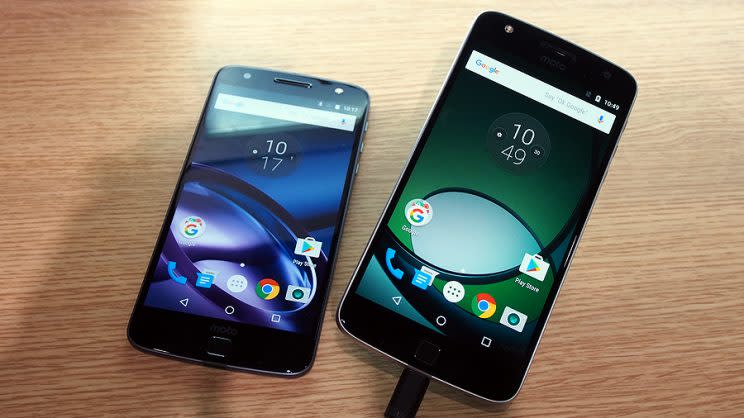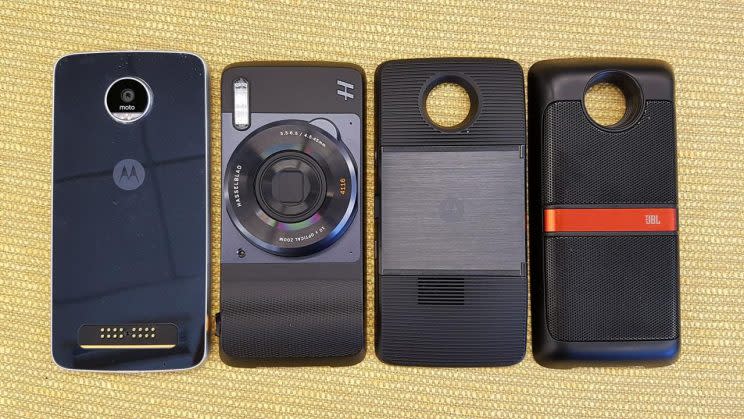A review of the Moto Z Play (and its mods)

Versatility. It’s a word that gets thrown around a lot when the latest smartphone is being discussed.
But when reflecting on the capabilities of the Moto Z Play, it’s truly an apt description.
The obvious appeal of the Moto Z Play, and its higher-end cousin the Moto Z, are its magnetic swappable mods.
But even if you had no interest in acquiring these pricey (but useful) add-ons, the phone is a solid offering from Motorola at a reasonable price.
The phone
The Z Play is the mid-range alternative to the Z, which is offered at a similar price point as its top-of-the-line competitors Google’s Pixel, the Samsung Galaxy S8 and the iPhone 7.
The 32 GB Moto Z Play is available with no tab from numerous retailers, including Rogers for $650 and $670 from Telus, while the 32 GB Moto Z is available with incumbent carriers such as Bell and Rogers for $900, while Freedom Mobile offers it for $949.
While the two phones may appear similar, their specifications and appeal vary drastically.
Camera
The area where the Z Play’s weaker specs, compared to the top phones in the market, is most glaring is its camera.
The Z Play packs a 16-megapixel camera, as well as five-megapixel selfie camera, in contrast to the Z’s 13 and five.
Compared to my Nexus 6P, which was released a year earlier and has 12.3-megapixel rear and eight-megapixel front cameras, I found the images to be of lower quality and grainier.
However, the Z Play took clear, half-decent photos even in low light.
One feature I did appreciate was the camera’s professional mode, which allows users to do fine-tuning that is usually reserved for DSLRs, such as changing the ISO and exposure.
Unfortunately, the Z Play camera does not have optical image stabilization, which could result in blurrier photos.
Battery
One area where the Z Play outclasses the Z is in battery life.
The Z Play is slightly thicker and heavier than the Z because it is loaded with a larger battery.
Motorola calls the Z Play’s 3,510 mAh battery its “longest-lasting,” with 50 hours of mixed usage. Meanwhile, the Z has a 2,600 mAh battery.
And the battery certainly lived up to the hype. The Z Play lasted a few days with mild usage before I had to plug it in.
Trials by CNET also found that the device lasted an astonishing 23 hours and 3 minutes while continuously playing video in Airplane Mode.
Performance
The Z Play has a less powerful processor (2.0GHz octa-core Qualcomm Snapdragon 625 versus a 2.2GHz quad-core Qualcomm Snapdragon 820) and less RAM (three GBs to the Z’s four).
Testing by CNET found that its Snapdragon 625 chipset fell short of the Z’s Snapdragon 820. Its findings also indicated that its direct competitors, the OnePlus 3 and the Alcatel Idol 4S outpaced it as well.
However, I found the Z Play more than capable of running all of my everyday apps — Instagram, Snapchat, Facebook, Twitter, YouTube, Netflix and Google Play — as well as graphics-heavy games such as FIFA Mobile and NBA Live.
Display
While they both boast a sharp 5.5-inch display, the Play’s 1,080-pixel resolution is a step down from the Z’s 1,440p.
But the colours to be vibrant and rich on the Z play, even if it not as crisp as my Nexus 6P, which also has a 1,440p display.
Exterior
The Moto Z Play is a sleek-looking phone.
It is minimalistic with a dark reflective backside, surrounding the Moto logo.
Unfortunately, its rounded brushed-metal edges give a slightly cheap appearance.
It also has a water-repellent nano-coating.
Its power and sound buttons are also well-placed on the upper-right side.
Coming in at 156.4mm by 76.4mm by 6.99 mm, it’s also a bit more of a pocket stretcher than its mid-range competitors, such as OnePlus 3, the Moto G4 Plus and the ZTE Axon 7.
It also weighs in at 165g, more than most of its counterparts.
However, another flaw may be the placement of its rear camera, which juts out from the back, leaving it vulnerable to falls and scratches.
The only other aspect that may lessen its appearance are the exposed magnetic bumps that are used to connect it to its swappable mods.
There’s good news for consumers looking for a phone that doesn’t require Bluetooth headphones, though.
The Z Play still has a 3.5-millimeter jack, unlike the Z, located on the bottom right corner of the phone.
The Z Play also has a fingerprint scanner on the front at the bottom. Other reviews have criticized this placement, as it could be confusing for consumers who are used to Apple’s home button, but I think it makes scanning while holding the phone with one hand much easier.
I find using the fingerprint scanner on my Nexus 6P, which is located in the centre of its backside, much more cumbersome, and is likely the most common reason why I drop it.
Mods

The main attraction of Z Play and the Z is clearly its mods.
I was able to test out the Insta-Share projector and the JBL SoundBoost speaker, and I’ve got to say, they’re pretty fun.
First of all, they’re really easy to attach and disconnect.
All you have to do is align the magnetic strip on phone with the bottom of the mod, which is easily identifiable as there’s a cut out for the camera at the top, and it simply slips into place. A beeping noise indicates when it has been properly connected.
Removing the mods is just as easy and it never feels as though you’re going to snap or break them.
JBL SoundBoost speaker
I listen to a lot of music, so I got to really put the JBL SoundBoost speaker to the test.
And it performed admirably.
The speaker’s sound quality is solid, if just falling short of the Bose Bluetooth speaker I have at home.
Its main failings were that it lacked the same punch and had some distortion at maximum volume.
It’s also solidly built, with a cool matte black exterior that is offset by an orange stand in the centre. It’s relatively thin, meaning you can save some space and have less things to worry about losing if you’re heading to the beach, for example.
It also has 1,000 mAh battery, which roughly amounts to 10 hours of battery that doesn’t have to be drained from your phone, according to Motorola.
And as it retails at about $100, it could actually work as a frugal and more mobile replacement for a Bluetooth or WiFi speaker, which often cost hundreds of dollars.
Insta-Share projector
The Insta-Share projector is also a very practical addition to the Moto Z Play.
As with the speaker, the projector feels solid and has a sharp, ribbed, matte-black exterior, which is complemented by its metallic stand in the centre.
But most importantly, the projector adds a new dimension to the smartphone. Instead of crowding over or passing around a phone to look at pictures or videos, users can simply attach the mod and project onto a nearby wall, creating a screen up to 70 inches.
In my experience, it was easy to focus and adjust the projector, and it is a great way to create an improvised home theatre experience.
It could also prove useful for users who frequently travel for work to easily make a presentation from their phone and eliminate the worry about technical issues at their next meeting.
The only drawback, besides being unable to use it and the speaker mod at the same time, is that the projector carries a hefty price tag of about $400.
The other two mods available for the Moto Z line are the Hasseblad True Zoom and the Incipio offGrid power pack.
The True Zoom adds a 10x optical zoom, xenon flash, a physical shutter and zoom controls.
Meanwhile, the power pack promises an additional 20 hours of battery life.
They retail for $350 and $90 respectively.
Conclusion
Overall, it’s hard to argue with the Moto Z Play’s package bang for your buck and flexibility.
It’s a capable performer, with a solid but average camera and fantastic battery life.
And while many of the mods are pricey, both the speaker and battery pack are affordable upgrades, and the projector is a great, albeit expensive, option for consumers who want to add another dimension to their smartphones.
These cutting edge options, mixed with versatility, reliability and affordability make it stand out from the mid-tier market.

 Yahoo Finance
Yahoo Finance 
